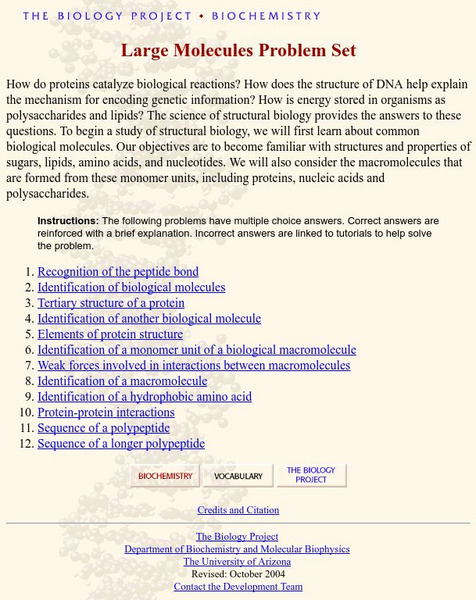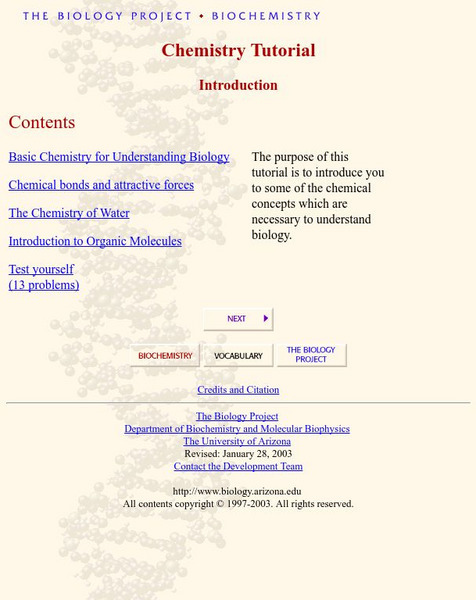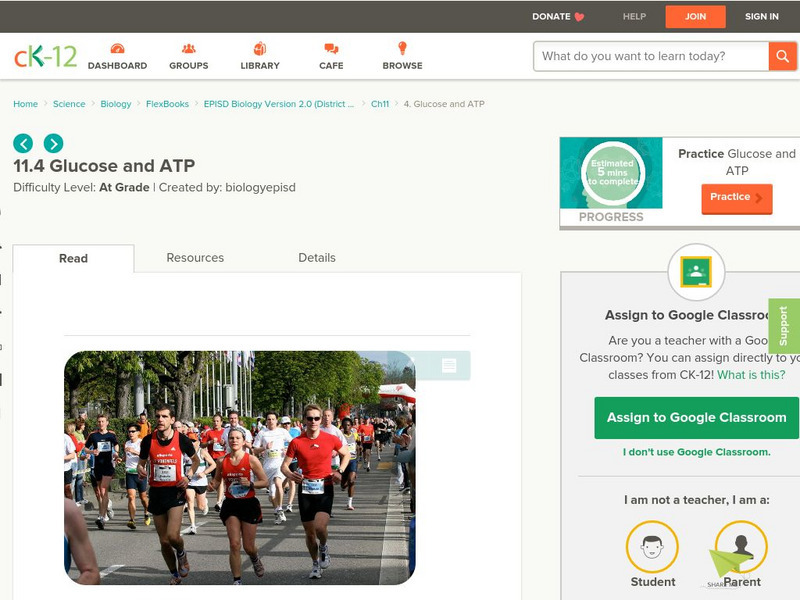Soft Schools
Soft Schools: Dna Quiz
Take this interactive, multiple-choice quiz over the molecule of life, DNA. Then review your score and any missed questions at the end.
Biotechnology Institute
Biotechnology Institute: Your World: The New Diagnostics [Pdf]
Discover new knowledge about molecular biology- how molecules fit together as a lock and key. This has given researchers new diagnostic tools that use immune cells from mice to produce antibodies to detect a specific virus or bacterium.
University of Arizona
Ua: Large Molecules Problem Set
Understandable lessons about numerous aspects about the composition, function, and interactions of proteins. Each starts with an interactive quiz and links to a tutorial.
University of Arizona
University of Arizona: Chemistry Tutorial
The purpose of this tutorial is to introduce you to some of the chemical concepts which are necessary to understand biology. Concepts include the basics for understanding biology, chemical bonds and attractive forces, the chemistry of...
BiologyWise
Biology Wise: Enzyme Substrate Complex
Discusses the properties of enzymes and the concept of enzyme-substrate specificity, and how a substrate molecule binds to an enzyme to form an enzyme-substrate complex. An overview of enzyme-substrate reactions is also presented.
BiologyWise
Biology Wise: Molecular Mechanism of Receptor Mediated Endocytosis
Endocytosis enables cells to absorb extracellular nutrients that are needed for their survival. In receptor-mediated endocytosis, a protein receptor on the cell membrane binds to a nutrient molecule and facilitates its absorption through...
Soft Schools
Soft Schools: Biochemistry and Organic Chemistry Quiz
Take an interactive quiz over biochemistry and organic chemistry. After completing the quiz, check your score, and then revisit any incorrect question for further review.
Open Curriculum
Open Curriculum: Cell Transport and Homeostasis
Students will be able to identify two ways that molecules and ions cross the plasma membrane.
Science Struck
Science Struck: Ribose vs. Deoxyribose
Explains what ribose and deoxyribose are, their chemical structure and properties, similarities and differences, their functions, and their biological importance.
BiologyWise
Biology Wise: What Is a Stop Codon?
A stop codon is a nucleotide triplet in messenger RNA that signals the end of a protein during the translation process. Read about how this works, the different types of stop codons, and how a mutation can sometimes occur.
BiologyWise
Biology Wise: Start Codon
A start codon is a nucleotide triplet in a genetic sequence that occurs at the start of a protein's synthesis. Read about how this works and how a mutation can sometimes occur.
Curated OER
University of Arizona: Fate of Excited Pigment Molecules
Biology Project tutorial from the University of Alabama explains the molecular events that occur as a pigment molecule absorbs a photon of light during photosynthesis.
Curated OER
University of Arizona: Fate of Excited Pigment Molecules
Biology Project tutorial from the University of Alabama explains the molecular events that occur as a pigment molecule absorbs a photon of light during photosynthesis.
Curated OER
University of Arizona: Fate of Excited Pigment Molecules
Biology Project tutorial from the University of Alabama explains the molecular events that occur as a pigment molecule absorbs a photon of light during photosynthesis.
Ohio State University
Ohio State University: Proteins and Nucleic Acids
This information can be used for exam review or as an introduction. It presents a good overview of the topics with charts, graphs, links, and a quiz.
Khan Academy
Khan Academy: Active Transport
Learn about gradients of molecules that exist across cell membranes, how they can help or hinder transport, and how active transport mechanisms allow molecules to move against their gradients.
Khan Academy
Khan Academy: The Calvin Cycle
Learn about the three stages of the Calvin Cycle reactions: carbon fixation, reduction, and regeneration of the starting molecule. See how the products of the light reactions, ATP and NADPH, are used to fix carbon into sugars in this cycle.
CK-12 Foundation
Ck 12: Life Science: Organic Compounds
[Free Registration/Login may be required to access all resource tools.] The main chemical components of living organisms are known as organic compounds and are built around the element carbon. Living things are made up of very large...
Khan Academy
Khan Academy: Connections Between Cellular Respiration and Other Pathways
Resource examines how non-glucose molecules such as carbohydrates, proteins, and lipids enter the cellular respiration pathway. Also, looks at the use of cellular respiration intermediates for biosynthesis.
Curated OER
Graphic of Dna Molecule
Problem sets, tutorials, and activities related to biochemistry.
Sophia Learning
Sophia: Diffusion: Lesson 2
This lesson explains the process of diffusion. It explains how diffusion is a passive form of transport, used to move molecules down their concentration gradient. It is 2 of 8 in the series titled "Diffusion."
Sophia Learning
Sophia: Diffusion: Lesson 4
This lesson explains the process of diffusion. It explains how diffusion is a passive form of transport, used to move molecules down their concentration gradient. It is 4 of 8 in the series titled "Diffusion."
Sophia Learning
Sophia: Diffusion: Lesson 1
This lesson explains the process of diffusion. It explains how diffusion is a passive form of transport, used to move molecules down their concentration gradient. It is 1 of 8 in the series titled "Diffusion."
CK-12 Foundation
Ck 12: Glucose and Atp
[Free Registration/Login may be required to access all resource tools.] Students take a look at glucose and ATP. They will be able to explain the structure of ATP and will learn how ATP is a source of energy for a cell.



![Biotechnology Institute: Your World: The New Diagnostics [Pdf] Article Biotechnology Institute: Your World: The New Diagnostics [Pdf] Article](https://d15y2dacu3jp90.cloudfront.net/images/attachment_defaults/resource/large/FPO-knovation.png)











